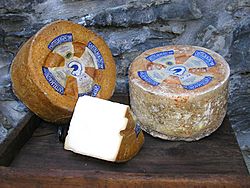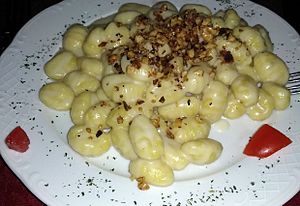Castelmagno cheese facts for kids
Quick facts for kids Castelmagno (DOP) |
|
|---|---|
 |
|
| Country of origin | Italy |
| Region, town | Piedmont: province of Cuneo |
| Source of milk | Cows, ewes, goats |
| Pasteurised | No |
| Texture | Semi-hard |
| Aging time | 60 days |
| Certification | EU: PDO 1996: Reg. CE n.1263/96 (OJEU L. 163/96 of 02.07.1996) |
| Named after | Lua error in Module:Wikidata at line 70: attempt to index field 'wikibase' (a nil value). |
Castelmagno (DOP) is a famous Italian cheese. It comes from the Piedmont region in north-west Italy. This cheese has a special status called "Protected Designation of Origin" (PDO). This means it can only be made in a specific area. It also must follow strict rules to ensure its quality.
Contents
What is Castelmagno Cheese?
Castelmagno is a semi-hard cheese. It is made from cow's milk. Sometimes, a little sheep or goat milk is added. This cheese is known for its unique flavor. It is aged for at least 60 days. The PDO status protects its name and tradition.
Where Does Castelmagno Come From?
Castelmagno cheese has a very special home. It is made only in the Valle Grana. This valley is in the south-west part of the Province of Cuneo. You can find it in the Piedmont region of Italy. The cheese can only be produced in three specific towns: Castelmagno, Pradleves, and Monterosso Grana. This small area helps keep the cheese's traditional taste.
How is Castelmagno Cheese Made?
Making Castelmagno cheese is a careful process. It starts with fresh milk from cows. These cows are usually of the Piedmontese breed. They eat fresh grass or hay from local meadows. This special diet helps give the milk its unique flavor. The cheese is considered "half-fat." After the cheese is formed, it needs to age. It must be aged for at least 60 days. This aging process gives Castelmagno its semi-hard texture.
How to Enjoy Castelmagno Cheese
Castelmagno cheese is delicious on its own. But it is also used in many Italian dishes. You can melt it into a creamy fondue. It can also be used in sauces like veloutés. People often enjoy it with rice or pasta. It tastes great with polenta, too. Some like it with thinly sliced raw beef, called carpaccio. Grilled vegetables are another good pairing.
See also
- Castelmagno (queso) para niños (in Spanish)


